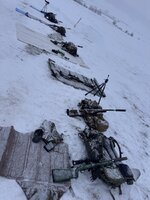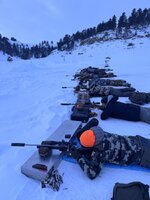here is from tikka t3x manual:
Routine cleaning should always take place right after use of the rifle (even without shooting). Maintenance should
not be neglected even in case of the “All-weather” or “Stainless” models. Corrosion can begin within 24 hours if the
rifle is not cleaned after use. It is recommended to support the rifle with the bipod during cleaning. Use only high
quality gun oil that cleans, lubricates and preserves (CLP). Routine cleaning procedure is done as follows:
1. Ensure that the rifle is unloaded and remove the bolt and magazine
2. In case the rifle has been used in wet conditions dry it using compressed air or let it dry in a warm / dry place
without any protective cover i.e. drag bag.
3. Use an absolutely straight, sturdy and smooth cleaning rod fitted with bronze bore brush soaked in bore solvent
and push-pull it through the bore until major residue is removed (approx. 10-15 times). It is recommended to
use cleaning rod guide to prevent the rod from dragging on the inner surfaces of the bore and receiver.
4. Push a clean felt pellet moistened with cleaning solvent through the bore one after another until pellets come
out clean (approx. 5-10 times). Clean only in the direction of bullet movement and replace dirty pellet with new
before every cleaning sequence. Guide the cleaning rod with fingers or special bore guide.
5. Clean the inner surfaces of the receiver from all the firing residue with felt pellet and/or brush moistened with
cleaning solvent.
6. Use a small solvent-wetted brush to clean the bolt from firing residue.
7. Use larger diameter nylon brush or particular chamber cleaning pellet moistened with bore solvent to clean
the chamber.
8. Pass a regular bore pellet moistened with rust preventive oil through the bore. Also, leave a thin coat of oil on
the cartridge chamber surface (remember to wipe it dry before shooting!).
9. Wipe all touching surfaces of the receiver and bolt with a very light coat of rust preventive oil.
10. Wipe the stock dry. In case of wooden stock, ensure that surfaces are lightly oiled with a proper wooden stock
oil.
11. Check the correct tightness of the receiver screws (fig. 5)



